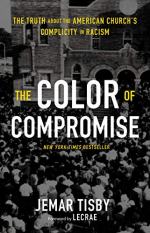
|
| Name: _________________________ | Period: ___________________ |
This test consists of 15 multiple choice questions and 5 short answer questions.
Multiple Choice Questions
1. What term does Tisby use to describe Christianity that "embraces racial and ethnic diversity" (24)?
(a) Complacent Christianity.
(b) Complicit Christianity.
(c) Courageous Christianity.
(d) Conscientious Chrsitianity.
2. According to slave codes, what determined whether a child was born free or enslaved?
(a) The father's religion.
(b) The mother's slave status.
(c) The father's slave status.
(d) The mother's religion.
3. What was the impact of chattel slavery on Black families?
(a) It allowed married couples to free their children.
(b) It usually kept families intact.
(c) It frequently broke up families.
(d) It kept couples together, but separated children.
4. How does Tisby view the U.S. Constitution?
(a) As a document that takes no stance on racial issues.
(b) As a proslavery document.
(c) As a document that upholds the rights of Black people.
(d) As an antislavery document.
5. According to Tisby, which of the following statements about Thomas Jefferson is NOT true?
(a) He drafted the Declaration of Independence.
(b) He was a slave-owner.
(c) He was an abolitionist.
(d) He opposed racial equality.
6. According to Tisby's statistical evidence, which modern American demographic is most likely to be religious?
(a) Asians.
(b) Whites.
(c) Blacks.
(d) Hispanics.
7. Which activist claimed that, "There can be no deep disappointment without deep love" (19)?
(a) W.E.B. Du Bois.
(b) Ida B. Wells.
(c) Rosa Parks.
(d) Martin Luther King, Jr.
8. According to Tisby, what attracted most Black people to Christianity during the Colonial era?
(a) The opportunity for education.
(b) The chance to win the vote.
(c) The prospect of higher wages.
(d) The hope of earthly liberation.
9. Which organization decided in the 1600s that baptism would not free enslaved people?
(a) The United Daughters of the Confederacy.
(b) The Virginia General Assembly.
(c) The Progressive National Baptist Convention.
(d) The Pentecostal Fellowship of North America.
10. Which piece of legislation prohibited Black people from gathering without white supervision?
(a) The U.S. Constitution.
(b) The Fourteenth Amendment.
(c) The Kansas-Nebraska Act of 1854.
(d) The Negro Act of 1740.
11. When was the first Black Episcopal Church established in New York City?
(a) 1803.
(b) 1811.
(c) 1809.
(d) 1784.
12. According to Tisby, during which period of American history did race NOT determine a person's station in society?
(a) 1600-1800.
(b) 1500-1700.
(c) 1900-2000.
(d) 1800-1900.
13. Why was the antislavery clause removed from the Declaration of Independence?
(a) States that profited from the slave trade objected to its inclusion.
(b) States that opposed the slave trade offended the Founding Fathers.
(c) States that outlawed slavery launched a letter-writing campaign.
(d) States that supported the slave trade won a Congressional vote.
14. Which for the following is NOT a reason Robert Finley cited in his proposal to send Black people back to Africa?
(a) This arrangement would "civilize" the continent of Africa.
(b) This arrangement would rid the U.S. of Black people.
(c) This arrangement would offer enslaved Blacks a better life.
(d) This arrangement would help the U.S. avoid paying reparations.
15. Which church leader helped found The Society for the Propagation of the Gospel in Foreign Parts (SPG)?
(a) George Whitefield.
(b) Jonathan Edwards.
(c) Thomas Bray.
(d) Francis Le Jau.
Short Answer Questions
1. Which war allowed Britain to expand their territory in North America in the mid-1700s?
2. At the Constitutional Convention, delegates allowed the question of slavery to be set aside for 20 years. What term has been used to describe this compromise?
3. What was the name of the Black writer who published an autobiography in 1861, detailing her experiences as a enslaved girl?
4. How many people perished during the Middle Passage?
5. How does Tisby categorize his book, The Color of Compromise?
|
This section contains 590 words (approx. 2 pages at 300 words per page) |

|




